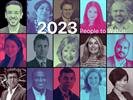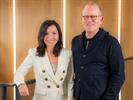Maja Pawinska Sims 11 Oct 2021 // 7:09AM GMT

Diversity has been one of the most important topics in the PR industry for the past couple of years. Rightly, especially in Western markets, much of the focus has been on the critical issues of attracting and truly including more employees from a broader range of racial backgrounds. The challenge of achieving a broader socio-economic balance within agency and in-house communications teams is also very much on the agenda. And, lest we forget, we still have a sizeable gender pay gap to contend with.
One of the biggest arguments in favour of a diverse workforce is not just that it’s the right thing to do, but that it makes business sense: it’s accepted that a PR agency or in-house team cannot sustainably come up with the most creative, behaviour-changing ideas if everyone looks the same, has the same world view and experiences, and doesn’t mirror the breadth of the brand’s stakeholder communities.
But another facet of the diversity question has, so far, been largely ignored: how to make the industry more attractive to and inclusive of people who are neurodiverse. Neurodiversity is a term that refers to the natural differences between how people’s brains work. Most people are 'neurotypical', meaning that their brains function in the way society expects. However, a notable proportion of people — estimates vary from 10% to 30% — are neurodivergent, meaning that their brains learn and process information differently.
Neurodivergent conditions include attention deficit disorder (ADHD), autism (autism spectrum disorders including Asperger’s Syndrome), dyslexia (difficulty with reading, writing and spelling) and dyspraxia (difficulty with planning, practical and physical tasks and coordination). These conditions count as (often invisible) disabilities, rather than mental health conditions, although people who are neurodivergent often also present with co-conditions of anxiety, depression or other mental health issues as a result of their lived experiences in a society that they don’t always find easy to navigate.
Those whose brains are wired differently have, until recently, been seen as having medical conditions that need to be treated or cured. In other words, neurodiversity has largely been viewed as a negative trait. Just look at the language used: 'disorder' and 'deficit'. Indeed, it’s thought that up to 90% of autistic adults around the world are not in work; in the UK, the latest figures suggest that only 22% are in employment, making them the least likely to be in work of all disabled groups.
But the tide is turning, as businesses are waking up to the potential of alternative thinking styles. Belatedly, a whole range of advantages of hiring talent that is not neurotypical — from visual spatial strengths, to problem-solving, to hyper-focus, to creativity — are being recognised. As American journalist Harvey Blume wrote in the Atlantic in 1998, in what is believed to be one of the first print analyses of the topic, "Neurodiversity may be every bit as crucial for the human race as biodiversity is for life in general. Who can say what form of wiring will be best at any given moment?"
In particular, the best kind of wiring for some sectors, it seems, is neurodiverse, with many leading technology firms, for example, now exhibiting conscious bias towards recruiting and nurturing neurodivergent talent. Microsoft and SAP worked out earlier than most that positive discrimination towards those with autism, for instance, was a win-win game; both have since widened their autism hiring programmes to include a broader range of neurodivergent people.
Other huge global enterprises — JPMorgan, EY, Google and Ford among them — are also all now developing or running neurodiversity-at-work initiatives, with EY launching its 'Neurodiverse Centre of Excellence' in the UK this summer specifically to “boost client innovation”.
It doesn’t seem like a great leap to theorise that the creative industries are another good fit for people who are wired differently; in the PR sector, this may be especially true in recent years, amid expansion and diversification, from data and analytics to pure creative work.
One small agency leading the way is Milk & Honey PR, a multimarket business that recently appointed Alex Annable as an associate director, with additional responsibility for its diversity, inclusion and belonging programme. Annable, who first worked with agency founder Kirsty Leighton at WE Communications around 16 years ago, was diagnosed with ADHD and autism spectrum disorder (ASD) only in 2019, and says “a lot of my life now makes sense”.
Annable is frank in saying that she thinks her conditions went undiagnosed partly due to the nature of a fast-moving industry that, in London at least, is notorious for widespread use of alcohol and other stimulants. In fact, the prescribed medications for ADHD include amphetamines.
“I was high-achieving at school, but always ‘last minute’, and things fell apart at university when I struggled with deadlines,” she says. “People with ADHD often have an impulsive, addictive personality and, when not diagnosed, often self-medicate with recreational stimulants to calm a busy head. So when I fell into PR agency life, my ADHD was undetected for a long time. When I stopped drinking, that’s when some behaviours came up strongly, and there were complaints at work, and my psychiatrist asked if I’d ever been tested for ADHD and ASD. It made perfect sense.”
Annable is disarmingly open about her lived experience, and the challenges of functioning at work: “I was being asked to go into a highly-stimulating office and wondered why I couldn’t get work done. I am hypersensitive and hyper-stimulated in some environments; going on the Tube makes me stressed and anxious. I also have social anxiety and am often misunderstood as I can be very direct, I have no filter, I talk over people because I have issues with working memory and want to say something because I’m scared of forgetting what I want to say, or why I’m there. It can be really frustrating. A lot of traits are unconscious, and in an environment where there isn’t understanding, I become very mute.
“There are also certain things I’m not good at. I have no concept of time. I can be three times as productive doing something I love, and at other times I procrastinate. I can be good at complex stuff but not simple stuff. And I can’t sit still in meetings all day long — I now divide my days into three-hour chunks with a break in between.”
But she also believes there are clear advantages to employing neurodiverse people in an industry that relies on creative ideas: “I can see links between things that other people don’t. I can come up with out-of-the-box ideas that maybe a neurotypical person wouldn’t think of, and I take more creative risks. I’ve taken risks in pitches where we’ve been hired purely because the client liked that we took a completely different approach to everyone else.”
Annable’s story shows that neurodivergence does not have to be career limiting and may even be relatively common among successful entrepreneurs. Let’s not forget that Richard Branson, the founder of the Virgin empire, and Ikea’s Ingvar Kamprad were diagnosed with ADHD, and there was much speculation that Apple boss Steve Jobs had undiagnosed neurodivergent traits.
In the PR industry, one of the earliest leaders to be vocal about her different wiring was Nik Govier, co-founder of two multi-award-winning agencies — Unity and now Blurred — who was diagnosed with dyslexia when she was a young teenager, and also has two children with dyslexia.
“I was constantly told I was careless and lazy on my school reports, because smart kids can hide it,” says Govier. “Eventually a supply teacher said she thought I was dyslexic and I am, quite severely. But genuinely for me it’s a superpower, partly to prove everyone wrong: my entire professional career has been about proving I’m neither stupid nor lazy. It’s driven me so powerfully.”
Govier points out that dyslexia isn’t all about bad handwriting, and the way the brains of many dyslexics work can be a real advantage in the communications industry: “It can manifest in a rewiring of the way you look at the world. I put so much of where I’ve got to down to being able to see the big picture really easily. I can be given a client problem and see the whole thing, instantly. It does relate to the kind of things we have to do, the ability to think round corners and problem solve. My brain naturally finds different ways of doing things and I naturally rebel against everything. Having an enquiring mind and being constantly excited about new ways of doing things is brilliant for our industry.”
There are still areas of difficulty for people with dyslexia in PR, despite the advent of spellchecks — Govier says “On some things I’m really useless. I get confused about timezones, they blow my mind” — but she says there has been far greater understanding about the condition in recent years: “I’m really open about it now — it was only five years ago that I put a dyslexia disclaimer on my email signature.”
Lyndon Johnson is another neurodivergent PR professional — he is a high-functioning autistic with obsessive compulsive disorder — who has succeeded by building his own business after struggling in the traditional agency world. He is also extremely open, even though he said our conversation was one of the first times he’d been asked to talk in depth about his lived experience and how it relates to the communications industry.
“When I was very young, I didn’t see the world in the same way as people around me did. It made me feel different and it was obvious to people around me that I was different. They didn’t necessarily have the understanding or acceptance and I was bullied,” says Johnson.
“Then I did a degree in broadcast journalism and it was great, because I am more curious than a non-divergent person, I’m always asking questions, finding stories other people wouldn’t find. I’m also really good at pattern recognition and seeing things other people don’t see, but I don’t always see things that are obvious to people who don’t have the conditions I have. I went through the traditional agency career path — I was tolerated because there were certain things I could do that made me valuable, but being different also held me back. So I moved to Canada 11 years ago and decided to start my own business for start-ups and small businesses that couldn’t get help from traditional agencies.”
Johnson’s business is called Think Differently: both a nod to Apple’s legendary ‘Think different’ advertising campaign, and acknowledging that he is neurodivergent: “It often comes up in conversation that the work we do will highlight things clients haven’t thought of, and we ask questions that force them to think differently about assumptions they are making.”
He agrees with others that neurodiversity can be a “superpower” but caveats that it can also be “major kryptonite”: “There are things I do really well and things I really struggle with, and I can offset the two things in my own business in a way I couldn’t do in another agency. Part of the thing about OCD is that because it’s an anxiety disorder and I have intrusive thoughts that trigger a view of the world that may not necessarily be reality, it doesn’t always give me the ability to rationalise things. It also means my life is governed by routines and coping mechanisms to manage the anxiety. One of the manifestations is a nervous tic, so that can be more or less visible. I’ve developed mechanisms for minimising it, but some days it’s pretty bad.”
So how can employers in the communications industry create an environment where neurodivergent people are set up for success? Govier’s top tip is very clear two-way communication: “If you believe there is value in having neurodiverse people in your business, then tell them you purposefully want them. And give people the opportunity to say what they need. We ask people for five personal needs when they join us, and the opportunity to say things like ‘I’m built slightly different, I can be triggered if people talk to me in a way that makes me feel stupid, this is how to get the best out of me.’”
According to everyone I spoke to, the new hybrid and flexible working models are likely to be extremely helpful in encouraging more neurodiverse people to speak up about what works for them, rather than not choosing PR or dropping out of the industry because the pre-pandemic agency world was too intense and overwhelming.
“The new world of work is likely to lead to a more welcoming environment in the industry for neurodiverse people to be their true, best selves,” says Govier. “As long as people set out personal boundaries and they are respected, a real diversity-friendly environment will allow people to dictate what works for them. The office of the future will have to consider we’re not all the same — that’s the great gift, because we bring different ideas and brainwaves to solve big problems.”
Johnson agrees, but adds that the intrinsic nature of spectrum disorders means that everyone’s experience is different, and employers must approach everyone as individuals rather than having a “process” for dealing with those who are neurodiverse: “Creating a standard or process for how you deal with neurodivergent people can add another layer of stress — a challenge for me was always trying to fit within someone else’s idea of what’s ‘helpful’.
“The best way to embrace and allow people to flourish is to let them define what their experience of working life looks like — obviously now there is more opportunity for people to set up their workspace and day in a way that works for them. There are challenges, but if we don’t embrace the things [that] make people different we’re missing a huge opportunity.”
One of the recruitment challenges the PR industry faces is bringing in young talent across all the facets of diversity. At digital agency Mediaworks, the team has just hired its first graduate with ADHD, Jessica Watson-Holmes, who wrote a blog post about her experience in higher education.
“I was diagnosed in January when I was 23, and it has made a huge difference to learn more about ADHD, coping mechanisms and connecting with other people after spending about 10 years in and out of mental health services, not really understanding what was wrong,” says Watson-Holmes. “There are still taboos around ADHD, including because the meds are stimulants. I cried when Mediaworks said they wanted me for my brain and my ideas — the very things other people have always said set me back.
“Education and most industries are very tailored to neurotypical people, but a lot of how neurodivergent people think is beneficial to the creative industry. Instead of finding ways to push ideas further, I often have to find ways to reel them in a bit.”
Mediaworks head of strategic planning Becca Tredget says that communication has been essential to ensuring Watson-Holmes feels supported as she starts her career: “It’s about always talking — for us communications has been super-key, and we’ve had really honest, open conversations. Her diagnosis didn’t faze us, we didn’t have any experience of ADHD but we’re adapting and learning. Part of her personality is that Jess has a lot of strings to her bow. She’s creative, logical and works well with data, so we’ve made her a role which sees her go round several departments, just to get experience and see where she might be best placed.”
And Tredget says taking on a graduate with ADHD has so far only been a win-win for the business: “If ADHD is managed properly, it’s a massive asset. It’s not something to be scared of, it’s actually a bit of a superpower, and for us it’s thinking about the positives, Jess’ hyper focus and creative thinking outside the box — that’s exactly the kind of people I want on the team.”
In her blog post, Watson-Holmes points out that ADHD is often diagnosed late, especially in women, as most research into the condition — and indeed autism — has been done on boys and men, and women tend to be better at “masking” conditions. This is borne out by Annable’s experience, and is also close to the heart of Dr Jane Brearley, who set up Intent Health last summer after 25 years in healthcare communications, with the deliberate intent of creating a truly diverse agency.
“I had to educate myself an awful lot, because everyone’s needs are different. Women with ADHD often have completely different symptoms to men — they don’t come across as the ‘can’t sit still’ stereotype. And the big learning I had around ADHD in women and lack of diagnosis was that when we hit menopause, the symptoms get worse. Late diagnosis in women is common — in fact I’m about to go into diagnosis myself.”
Brearley said the burden of “masking” ADHD is particularly acute among women, who also frequently experience “rejection dysmorphia” when they have the condition, immediately blowing any negative feedback out of proportion. “Agencies want to hire cookie cutter people, so if you are different you have to mask to be successful, and that breaks people.”
Intent Health works with a number of specialist diversity organisations and Brearley now has five neurodivergent people on her team of 20. “I really thought about the interview process and how people shy away from heavy recruitment processes and filling in forms. I couldn’t find a recruitment portal that was non-exclusive so I did a DIY version. I ask people just three questions — tell me about yourself, why do you care about healthcare and why do you care about diversity — and they can send in videos if they prefer. The feedback has been that it is not such a daunting prospect, so people are so much more able to express themselves.”
Brearley echoes that many neurodiverse conditions are spectrum disorders, which require real understanding of the individuals concerned. For instance, some team members like meetings to be recorded so they can go back and re-listen to what was said; others find verbal briefings difficult and prefer a written brief followed by a conversation; some require support with time management and deadlines; some need to work different hours depending on when their medication kicks in; a team member with Tourette’s found presenting to clients challenging, and needed coaching and support to help him become more comfortable and confident.
“It’s all about time and space for processing, and being flexible, and having understanding and empathy,” she says. “Our open culture here enables people to acknowledge they may have acted in a certain way because of their condition — people don’t have to mask or hide here for any reason and really can bring their whole self to work. Everyone has individual development plans around what they need to thrive — but that’s hard to do at scale.”
Another agency that is starting to nurture neurodivergent talent as part of its focus on all aspects of diversity is technology specialist CCgroup, where senior account executive Matt Denby is, like Govier, dyslexic.
Head of enterprise tech Katie de Cozar says: “Dyslexia is the neurodiversity we have most experience with, but that might be because it’s one most openly talked about — and because it’s the least stigmatised. There’s traditionally been an expectation for PR people to fit into a certain box. Act, behave, operate in a certain way. What’s more, writing has traditionally been a core part of the PR role, whether in agencies or in-house. And for people living with dyslexia, for example —this can be challenging. It feels like we’re on the cusp of a neurodiversity movement, though.”
She says this is partly down to the industry-wide spotlight on diversity in general, and partly down to the way the industry is evolving — the enhanced role of data in storytelling, for example. “Research shows that dyslexics are especially good at putting together big pictures, or seeing larger context, imagining how processes will play out over time. The integration of PR and digital has extended opportunities for people.”
From Denby’s point of view, he says: “I don’t think it’s something that companies have started paying attention to until recently. I avoided saying anything about dyslexia in interviews over fears that I’d be rejected. At the time I didn’t see my disabilities having any competitive advantage.”
But he says PR is proving to be a good fit: “Working in comms means that you explore lots of disciplines, giving you the chance to find one that you enjoy and thrive under. I don’t need to be worried that I might have to constantly labour over writing longform content, because there’s so many other things I could be doing.”
Smaller, independent firms with a will to do so may find it relatively uncomplicated to accommodate neurological difference at both graduate and more senior levels, but what has the experience been for large, networked agencies? Ketchum — the only large UK agency so far to achieve the Blueprint diversity mark and a vocal champion of all aspects of DE&I in the PR industry — has started work in this area with internships for those with autism.
Head of PR for Europe Kirsty Sachrajda says the process has been more complex than it might be for smaller businesses, but adds that Ketchum is committed to embracing neurodivergence, including a partnership with Ambitious about Autism that included a three-month paid internship in its corporate reputation community.
Sachrajda explains that overhauling the interview process was an important element of finding the right candidate: “The organisation advised on adjustments to our interview process, such as sending the candidates photos of the office space they would be interviewing in and sharing photos/bios of the people they would be interviewed by. We also shared the questions ahead of the interview to allow candidates the opportunity to prepare.”
Before the internship started, Ambitious about Autism also provided training to the team the person would be most closely working with, to support them in becoming more “autism-confident.” The internship was so successful, the agency is starting another this year, this time in its consumer brand team. But that’s not the end of the story: Sachrajda says the experience has made the leadership team realise that this isn’t just about bringing people into the business; it’s about recognising the make-up of the existing team.
“We know we have neurodivergent talent in the business beyond the work experience programme, so last month we partnered with Adjust to deliver mandatory ‘Neurodiversity Understood’ training for all Ketchum UK line managers,” she says. “We’re now going through a process to review and adjust our processes, policies, and office design to be more neuro-inclusive. These neurodiversity partnerships have been invaluable in guiding our progress. We have a responsibility to create an inclusive workplace where people with neurological differences can thrive and are valued.”
Another specialist non-profit organisation is The Future is ND, which was set up in 2018 by advertising art director Lucy Hobbs — herself diagnosed with ADHD a decade earlier — as a space for neurodivergent people in the creative industries to support each other.
“When I started organising events, people would be in tears, relieved to meet people like themselves,” she says. “There’s no such thing as normal when talking about neurodiversity. I can be really good at hard things and really rubbish at ‘easy’ things like admin. People with ADHD can be very creative, and our minds do tend to work quickly. But then we can also be inattentive. Techy people can be autistic, but not all, and autistic people can also be creative; the boundaries are blurred, and it's not helpful to generalise."
As all of these stories indicate, while neurodiversity brings challenges for employees and employers, many of the associated traits — from creativity to problem-solving, hyper-focus and spotting links and patterns — seem like a remarkably good fit for the PR industry. And many of those who I spoke to think it’s highly likely there is a lot of undiagnosed neurodiversity in the communications world.
Govier says: “I can spot it — and can also see how it can positively manifest itself. Neurodivergent people excel in fields where telling and understanding stories are important, and in dynamic settings where facts are incomplete or changing. If those attributes aren’t made for an industry like ours, I don’t know what are. There are so many opportunities for people to flourish.”
And Johnson agrees: “There are people I deal with day to day who aren’t diagnosed or even necessarily aware. Conversations I’ve had over the years have led to others’ diagnoses — they knew they were different but didn’t know why.”
Hobbs also points out that demographics would point to more neurodiversity in the creative industries than maybe had been previously thought: “Obviously if 15-20% of the population are neurodivergent, there will be more people in the industry by default who are hidden in plain sight, either diagnosed but they don’t want to talk about it because of stigma, or undiagnosed. A lot of people were diagnosed during the pandemic, as it brought a lot of things to a head. I’ve certainly worked with a few creative directors who may have had ADHD and didn’t know it, who were ‘different’.”
And Hobbs says the tendency of the creative industry to recruit ‘people like us’ who ‘fit’ the agency’s culture has been a barrier to hiring in all measures of diversity: “If you believe people don’t fit into your culture, that’s discriminatory — hire the people who don’t fit, as they will give you the best ideas. Be kind. Be aware. Change your recruitment process. Give people the benefit of the doubt. Hire for difference. And ask the people with lived experience to teach you about neurodiversity."
Brearley seconds this: “My top tip is to recruit differently. Educate yourself and everyone in your team. Don’t put people in a box — if you’re chucking out CVs because they have typos, has that person got dyslexia? Hire for potential: you can’t teach passion.”
Professor Jessica Nerren is a public relations lecturer at California State University, San Bernadino. Nerren was previously PR and marketing director at US law firm Berger Kahn, and a long-time publicist for an autism non-profit in California. She also has a son with autism.
Nerren has a different angle on inclusivity and neurodiversity in PR, since her academic dissertation looked at whether the strategies and advocacy tactics of public relations itself would be effective in increasing understanding of autism in an educational setting, and how to make classrooms inclusive for future teachers during their training.
Nerren told me that during the course of her research, perceptions among trainee teachers and professors shifted from an overarching and dominant “this is hard to do,” to being favourable to being inclusive towards neurodiversity — and quickly.
“In disability studies in general, the narrative is that disability itself is a social construction that says disability equals deficit. Once we did the work, using the tools of PR, there was a really powerful shift, reframing this social construction so disability — and ASD — was seen as an ‘asset in my classroom’. And this asset thinking happened in a short time frame: around 45 minutes.”
As a relevant, and poignant, side note, Nerren also highlights the “very dark history of disability” in the US, where ineffective data and bias has skewed statistics even in recent times. “Even today, people of colour get diagnosed later, and less frequently. There are people slipping through the cracks, and there are money, time and cultural barriers to diagnosis. But it’s becoming normalised that we are all worthy of having a work setting and environment that is tailored for us and set up so we can do our best work. We talk about inclusion as a separate entity from the course of doing business, or a cost, and that’s incorrect. All the way down, it’s an economic driver, and there is so much opportunity we haven’t fully tapped into.”
So could this academic work improve the PR industry's ability to understand and embrace neurodivergent people, helping them succeed in one of the industries that — as our examples would reflect — offers the real prospect of a mutually beneficial relationship?
“Absolutely,” she says. “This was made to carry over to commercial settings, as it comes from the communications concept of ‘show, don’t tell’."
Nerren believes the future is looking much brighter for neurodivergent people: “There is this population of individuals with autism where they are coming into adulthood having had amazing inclusion opportunities their whole lives and are already accomplishing amazing things. Their barrier wasn’t their disability — their barrier was us doing them dirty along the way. But the barriers have lessened as our thinking changes; there’s an opportunity to elevate their voices in powerful ways, and make that shift from deficit to asset.”
Resources:
Ambitious About Autism
The Future Is ND
Creative Equals
CIPD guide: Neurodiversity At Work
Adjust Services
Enable Disability & Inclusion Consultants
Genius Within


































.jpg)































